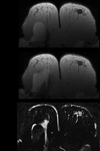Significance of breast lesion descriptors in the ACR BI-RADS MRI lexicon
- PMID: 19197974
- PMCID: PMC2748779
- DOI: 10.1002/cncr.24156
Significance of breast lesion descriptors in the ACR BI-RADS MRI lexicon
Abstract
In recent years, dynamic contrast-enhanced magnetic resonance imaging (DCE-MRI) has altered the clinical management for women with breast cancer. In March 2007, the American Cancer Society (ACS) issued a new guideline recommending annual MRI screening for high-risk women. This guideline is expected to substantially increase the number of women each year who receive breast MRI. The diagnosis of breast MRI involves the description of morphological and enhancement kinetics features. To standardize the communication language, the Breast Imaging Reporting and Data System (BI-RADS) MRI lexicon was developed by the American College of Radiology (ACR). In this article, the authors will review various appearances of breast lesions on MRI by using the standardized terms of the ACR BI-RADS MRI lexicon. The purpose is to familiarize all medical professionals with the breast MRI lexicon because the use of this imaging modality is rapidly growing in the field of breast disease. By using this common language, a comprehensive analysis of both morphological and kinetic features used in image interpretation will help radiologists and other clinicians to communicate more clearly and consistently. This may, in turn, help physicians and patients to jointly select an appropriate management protocol for each patient's clinical situation.
(c) 2009 American Cancer Society
Figures











References
-
- Much wider use of M.R.I.’s urged for breast exam, Health. The New York Times, By Denise Grady Published; 2007. Mar 28,
-
- Saslow D, Boetes C, Burke W, et al. American Cancer Society Breast Cancer Advisory Group. American Cancer Society guidelines for breast screening with MRI as an adjunct to mammography. CA Cancer J Clin. 2007 Mar–Apr;57(2):75–89. - PubMed
-
- Tillman GF, Orel SG, Schnall MD, et al. Effect of breast magnetic resonance imaging on the clinical management of women with early-stage breast carcinoma. J Clin Oncol. 2002 Aug 15;20(16):3413–3423. - PubMed
-
- Bedrosian I, Mick R, Orel SG, et al. Changes in the surgical management of patients with breast carcinoma based on preoperative magnetic resonance imaging. Cancer. 2003 Aug 1;98(3):468–473. - PubMed
-
- Hylton N. Magnetic resonance imaging of the breast: opportunities to improve breast cancer management. J Clin Oncol. 2005 Mar 10;23(8):1678–1684. - PubMed
Publication types
MeSH terms
Grants and funding
LinkOut - more resources
Full Text Sources
Medical

